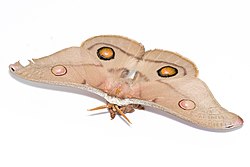Opodiphthera eucalypti
| Opodiphthera eucalypti | |
|---|---|
 |
|
| An emperor gum moth | |
| Scientific classification | |
| Kingdom: | Animalia |
| Phylum: | Arthropoda |
| Class: | Insecta |
| Order: | Lepidoptera |
| Family: | Saturniidae |
| Genus: | Opodiphthera |
| Species: | O. eucalypti |
| Binomial name | |
|
Opodiphthera eucalypti (Scott, 1864) |
|
Opodiphthera eucalypti, the emperor gum moth, is a species of moth in the family Saturniidae native to Australia. This species was formerly placed in the genus Antheraea.
The emperor gum moth may inhabit all states of Australia, however it is scarce in the more southerly states where the climate is less suitable. They are also found as an introduced species on both the North and South Islands of New Zealand.
Caterpillars can usually be found on young adult leaves between October and March (the Australian Spring and Summer). When the caterpillars hatch they are black with short hairs on top of small nodes on their bodies called tubercles. The hairs are not poisonous and will not sting. As the caterpillars mature they change color each time they shed their skin (which totals to five stages in the caterpillar's appearance). The fully grown caterpillars are usually found on the highest branches of the host tree where the leaves are the youngest and easiest to digest. By the final stage before pupation the caterpillars have developed striking coloration, having a yellow/cream stripe down their bright green/blue body and nodes of red and blue. Despite this they are still surprisingly hard to spot. The caterpillar stage in the emperor gum moth's life cycle can last for many weeks, depending on the temperature and weather conditions.
When the caterpillar is fully mature it spins a dark brown silken cocoon on a branch which usually has a leaf to protect it with. When spinning is complete, the caterpillar sheds its final skin and takes the form of its pupal life stage. Within a day of spinning completion, the cocoon sets to a hard waterproof shell with a rough exterior and a smooth interior wall. Air holes can be seen along the side of the cocoon indicating that the cocoon is probably otherwise airtight. The moth usually emerges from the cocoon the following year (in Spring or early Summer) but depending on weather conditions can stay in the cocoon from anywhere between two and five years. One case has even been recorded of a moth emerging out of the cocoon after 10 years.
...
Wikipedia
